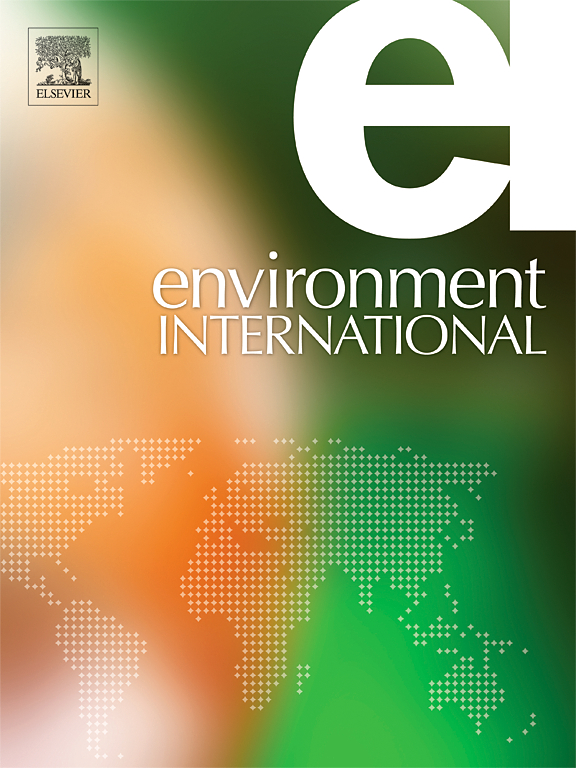Perfluorodecanesulfonate (PFDS) induces innate immune toxicity through the NF-κB pathway in early life stage zebrafish
IF 10.3
1区 环境科学与生态学
Q1 ENVIRONMENTAL SCIENCES
引用次数: 0
Abstract
Perfluorodecanesulfonate (PFDS), a long-chain polyfluoroalkyl substance (PFAS), is widely detected in aquatic environments and increasingly recognized for its environmental persistence and bioaccumulative potential; however, its immunotoxicity remains poorly understood in aquatic biota. In this study, early life stage zebrafish (Danio rerio) were exposed to environmentally relevant concentrations of PFDS and PFOS for 120 h to better characterize the adverse effects of PFDS on aquatic organisms. Additionally, the toxicological differences between PFDS and PFOS at the same exposure concentrations were compared, as PFDS is a known substitute for PFOS. PFDS bioaccumulated in zebrafish larvae at environmentally relevant concentrations, which disrupted immune function by altering the number of macrophages and neutrophils, inducing oxidative stress, and dysregulating immune markers such as interleukins and immunoglobulins. Mechanistically, PFDS activated the nuclear factor kappa B (NF-κB) signaling pathway, driving pro-inflammatory cytokine expression and immune dysfunction. Furthermore, the use of a NF-κB morpholino knockdown confirmed the role of the NF-κB pathway in mediating PFDS-induced immunotoxicity. These findings provide the first comprehensive evidence of PFDS-induced immunotoxicity being mediated through NF-κB activation, offering novel insights into the ecological risks of long-chain perfluorosulfonic acids. Notably, PFDS exhibited a stronger immunotoxic response relative to PFOS, indicating that its adverse effects may be more severe. Overall, these findings provide valuable insights for the ecological risk assessment of PFDS and the toxic potential that unregulated PFAS can have to aquatic systems.


全氟十烷磺酸盐(PFDS)通过NF-κB通路诱导斑马鱼早期先天免疫毒性
全氟十烷磺酸盐(PFDS)是一种长链多氟烷基物质(PFAS),在水生环境中被广泛检测到,并因其环境持久性和生物蓄积性而日益得到认可;然而,其免疫毒性在水生生物群中仍知之甚少。在本研究中,为了更好地表征PFDS对水生生物的不利影响,将生命早期的斑马鱼(Danio rerio)暴露于环境相关浓度的PFDS和PFOS 120 h。此外,由于PFDS是已知的全氟辛烷磺酸替代品,因此比较了相同暴露浓度下PFDS和全氟辛烷磺酸之间的毒理学差异。PFDS以环境相关浓度在斑马鱼幼虫体内生物积累,通过改变巨噬细胞和中性粒细胞的数量,诱导氧化应激,以及调节白细胞介素和免疫球蛋白等免疫标记物来破坏免疫功能。机制上,PFDS激活核因子κB (NF-κB)信号通路,驱动促炎细胞因子表达和免疫功能障碍。此外,利用NF-κB morpholino敲低证实了NF-κB通路在介导pfds诱导的免疫毒性中的作用。这些发现首次提供了pfds诱导的免疫毒性通过NF-κB活化介导的综合证据,为长链全氟磺酸的生态风险提供了新的见解。值得注意的是,相对于全氟辛烷磺酸,PFDS表现出更强的免疫毒性反应,表明其不良反应可能更严重。总的来说,这些发现为PFDS的生态风险评估和不受管制的PFAS对水生系统的毒性潜力提供了有价值的见解。
本文章由计算机程序翻译,如有差异,请以英文原文为准。
求助全文
约1分钟内获得全文
求助全文
来源期刊

Environment International
环境科学-环境科学
CiteScore
21.90
自引率
3.40%
发文量
734
审稿时长
2.8 months
期刊介绍:
Environmental Health publishes manuscripts focusing on critical aspects of environmental and occupational medicine, including studies in toxicology and epidemiology, to illuminate the human health implications of exposure to environmental hazards. The journal adopts an open-access model and practices open peer review.
It caters to scientists and practitioners across all environmental science domains, directly or indirectly impacting human health and well-being. With a commitment to enhancing the prevention of environmentally-related health risks, Environmental Health serves as a public health journal for the community and scientists engaged in matters of public health significance concerning the environment.
 求助内容:
求助内容: 应助结果提醒方式:
应助结果提醒方式:


